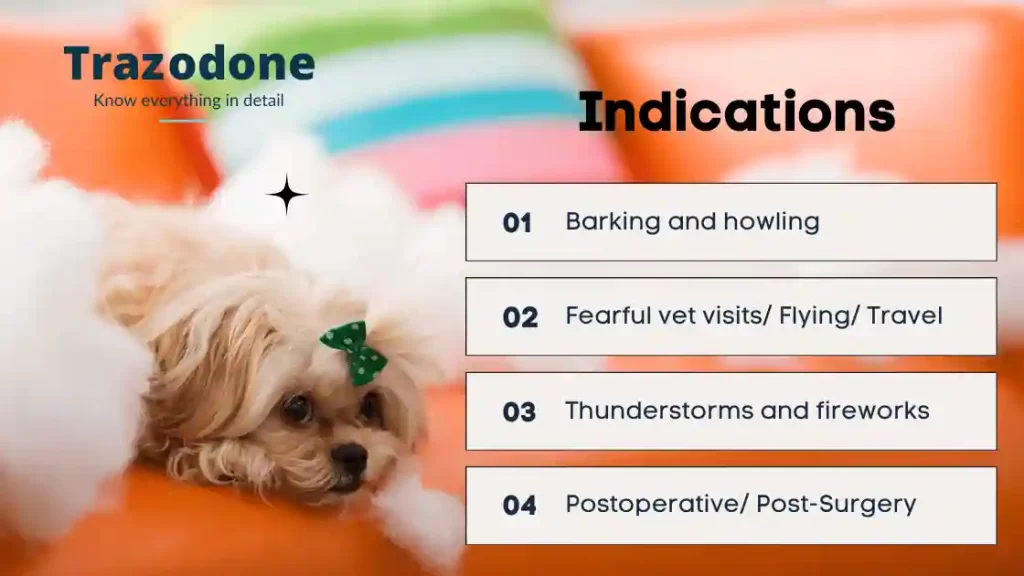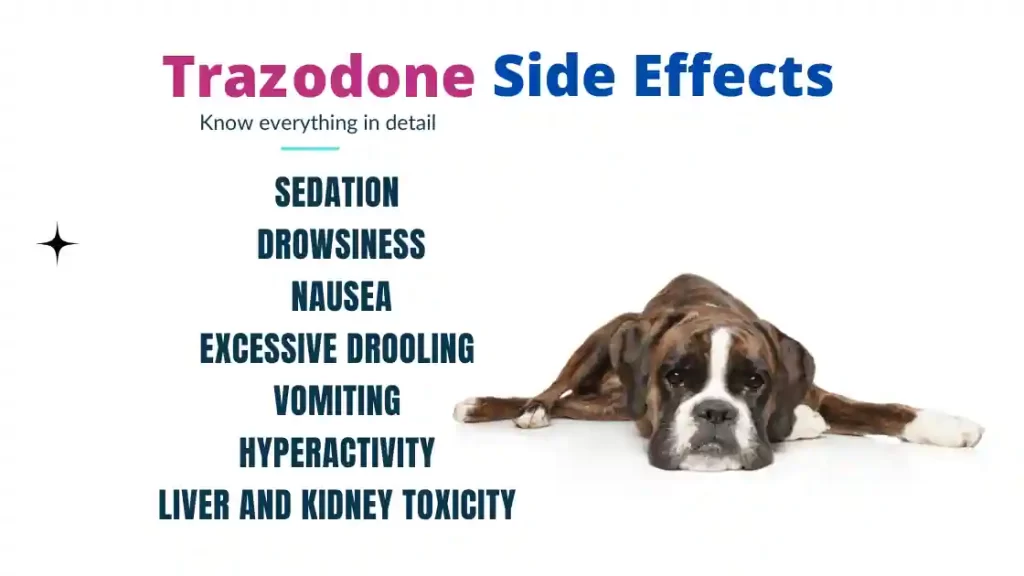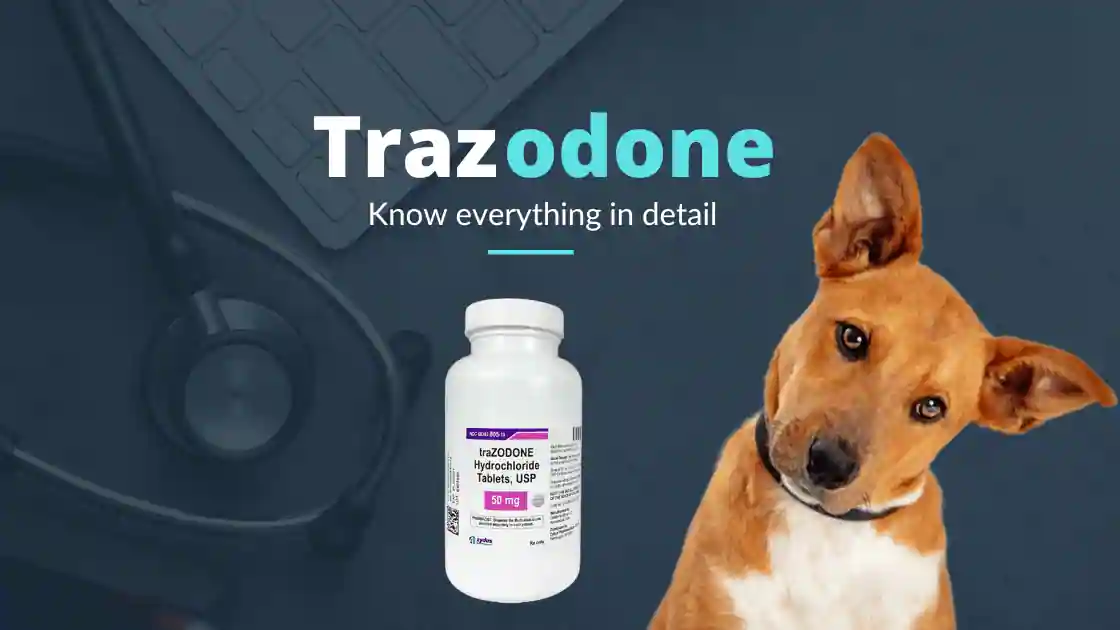Aggression is common dog behaviour but sometimes it may need to address. Now a days Trazodone is being used in dogs to treat anxiety, stress, aggression. Typically, it is an antidepressant which works by inhibition of serotonin reuptake in the brain. Serotonin promotes sense of wellbeing. It results in the behaviour modulation of pet. It is also indicated can cats for management of short-term anxiety related problems. Trazodone dosage chart by body weight in kg for dogs can be helpful.
What is Trazodone?
Trazodone is an atypical short acting anti-depressant medication. It is a triazolopyridine derivative which belongs to phenylpiperazine group of drugs acting on CNS. It comes in the form of uncoated tablets, capsules, and liquid which contain Trazodone hydrochloride as an active ingredient. It is not an FDA approved drug as a veterinary medication.
How does Trazodone work?
It is weak selective serotonin reuptake inhibitor (SSRI). It has both antagonistic (5-HT2A) and agonist actions on serotonin receptors. It prevents reuptake of serotonin in the brain and thus increases serotonin levels in the brain and help in reducing anxiety and depression or unwanted impulsive behaviours. It also has sedative and anxiolytic effects. It may also have hypotensive effects.
It has a half-life of 6 to 9 hours in human but around 3 hours in dogs. It is primarily metabolised extensively in the liver and predominantly excreted by kidneys.
Indications:
Generally, it is used in combination with other drugs for effective management or treatment of aggression. It is used when dogs are unresponsive to other pharmacological preparations for treatment of chronic anxiety related problems. Due its anxiolytic and sedative effects it is used before veterinary or groomer visits, before travelling by car, airplanes, or other types. For better surgical outcomes/ healing it is used postoperatively. It helps them in keeping anxiety free and calm during the procedures.
To summarize it is used for the treatment or management of following conditions in dogs (including off label uses)-
- Depression
- Major depressive disorder (MDD)
- Anxiety and insomnia related to depression
- Stress
- Separation anxiety
- Compulsive behaviours
- Barking and howling
- Aggression
- Improves mood, appetite, and energy levels (in pets with anxiety)
- Fearful vet visits
- Thunderstorms and fireworks
- During post operative period
- Noise phobias
- In close confinement or hospitalized dogs
In cats:
- Short term anxiety
- Travel Stress
- Before vet visits or examination

Trazodone dosage by weight for dogs and cats:
Dogs:
For management of short-term anxiety:
4 mg/kg body weight twice daily orally
For management of chronic anxiety:
5 mg/kg body weight once or twice a day
Dosage Chart for 50mg and 100mg Trazodone tablets for dogs (By Weight):
Body weight Total Dose 50mg Tab 100mg Tab
5 kg 25 mg ½ ¼
10 kg 50 mg 1 ½
15 kg 75 mg 1 ½ ¾
20 kg 100 mg 2 1
25 kg 125 mg 2 ½ 1 ¼
30 kg 150 mg 3 1 ½
> 40 kg 200 mg 4 2
Appropriate combination of tablets can be used for easy dosing.
As it has sedative effect so incremental doses are recommended that means start with low dose and slowly increase the doses as needed. Start from the lower dose (like 25 mg for a dog of 10 kg, 50 mg for a dog of 20 kg etc.) and double the dose gradually in two weeks if required or as directed or recommended by a veterinarian. Do not give extra /double the dose in case of missed dose.
In any case of incremental doses do not exceed total dose more than 300 milligram at a time.
Cats:
50 – 100 mg per cat per os in 24 hours depending on the size of the cat
* It should be administered one hour before anticipated anxiety inducing event for optimal effect both in dogs and cats.
* In case of chronic anxiety management Trazodone alone is not effective show it can be used in combination with fluoxetine, clomipramine, gabapentin, melatonin and benzodiazepines.
* In case of combination with tricyclic anti-depressants or other SSRI drugs start with 2 mg/kg bodyweight.
Available dosage Forms:
Tablets/ Capsules: 50mg, 100mg, 150mg, 300mg
Liquid: 10 mg/ml
Brand names: Desyrel, Molipaxin, Oleptro,
* Extended release or sustained release tablets are not used in dogs/cats for short term anxiety treatment.
Precautions / Warnings/ Contraindications:
Do not use in dogs / cats with known hypersensitivity. Use with caution in patients with hepatic or renal disease and monitor regularly. Do not use for treatment in pets with history of seizures, urine retention, severe liver disease and suffering from glaucoma (narrow angle).
Safety in pregnant and lactating female dogs / cats has not been established. It may have teratogenic effects on foetus so use with caution if benefits outweighs the potential risk.
Concurrent use with ketoconazole will inhibit the breakdown of Trazodone. Should be used with caution with others serotonin re uptake inhibitors (SSRI) like Fluoxetine, opioids like tramadol and monoamine oxidase inhibitors like selegiline, amitraz. Trazodone in combination with antibiotics like erythromycin (macrolides) and antifungals like ketoconazole (azole antifungals) may give more sedative effect.
Always check history of ongoing and recent medications/ treatment carefully before starting Trazodone for chronic anxiety treatment.
Other drugs that can affect metabolism or response are:
- CNS depressants
- Digoxin
- Anti-hypertensive drugs
- Macrolides (erythromycin)
- Carbamazepine
- Phenobarbital
- Phenytoin
- Rifampicin
- Amitriptyline
- Clomipramine
- Amphetamines
- Dextromethorphan
- Metoclopramide and Ondansetron
What are side effects of Trazodone?
Common side effects and symptoms of serotonin syndrome are:
- Sedation / Lethargy / Drowsiness / Seizures
- Increased appetite
- Behavioural disinhibition / Altered mentation
- Nausea, Excessive Drooling and Vomiting
- Arrhythmia (Tachycardia) and Hypotension
- Urinary incontinence
- Diarrhea
- Agitation / aggression (growling)
- Colitis
- Priapism (erection of the penis)
- Muscle tremors or twitching / Ataxia / Disorientation
- Hyperactivity (paradoxical effect) / Hyperesthesia
- Liver and kidney toxicity in rare
* To minimize the potential side effects start with the lower doses and gradually increase with the time.
Signs of overdose can be noticed within 30 – 60 minutes after administration and may last up to 24 hours. Keep an eye on the dog’s activity and behaviour and report to your veterinarian in case of any adverse side effects. Supportive and symptomatic treatment can be instituted immediately. Intravenous administration of fluids can prevent hypotension and diazepam is helpful for control of nervous signs. Atropine sulphate administration can help in prevention of bradycardia. Cyproheptadine is a serotonin and histamine antagonist that can help in combat against serotonin syndrome. Always check history of concurrent medications for other ailments before starting trazodone.
In case of accidental overdosing vomition can be induced within one hour. Administration of activated charcoal may help.

How to give it to your dog?
Can be given directly or along with the wet food or hide in pill pocket to make administration easier. When it is given along with the food effectiveness is better.
Alternatives to Trazodone:
Trazodone alone is not effective for the treatment of chronic anxiety. Activities like desensitization and counterconditioning exercises, training sessions, and socialization events can help in managing stress and anxiety in pets. Alternatives can include other antidepressants, anti-anxiety medications, and natural supplements like CBD oil. Medications like alprazolam, gabapentin, diazepam etc can be used for the management of sedation and anxiolysis. Your veterinarian can help you determine the best course of treatment for your dog based on their individual needs and symptoms.
How to store?
Store at 68°F to 77°F in controlled room temperature in a tightly closed container. Store away from reach of pets and children.
Conclusion:
Trazodone is safe drug and usually prescribed for management of stress or anxiety (firework and thunderstorm phobias, separation anxiety, and to minimize activity after surgeries) in dogs and cats. It may have some potential side effects like sedation, lethargy but can be minimised with starting from lower doses and gradual increment with the time.
FAQs:
How fast Trazodone works in dogs?
For short term anxiety related events like veterinarian visits it should be administered at least one hour before. Peak concentration in blood is established in 3 hours. In long term use for management of chronic anxiety or behavioural issues results can be observed with incremental doses in 2 to 4 weeks.
Trazodone for dogs: how long does it last?
Redosing is required in 12-24 hours depending on the effect. Elimination half-life is around 3 hours. Owner observed duration of effect reported by Guren et al was 4 hours or more.
Gabapentin and Trazodone together?
Both the medicine have different mechanism of action and can be combined together for effective short term anxiety management like vet / groomer visits as trazodone alone may not be so much effective. This combination might be more effective but sedative effect may be additive or more so use with caution.
How to get trazodone for dogs?
It is a prescription only medicine and require a prescription from registered veterinary practitioner.
How does trazodone make a dog feel?
It works by inhibiting reuptake of serotonin in the brain so gives feeling of wellbeing and relives from anxiety.
Will trazodone put a dog to sleep?
Yes, it will help in calming your dog. Initially it may have sedative effects and can make dog feel drowsy. Euthanasia is not recommended by overdosing with trazodone.
How much trazodone will calm a dog?
Depends on the use. Dosage may vary from 5-10 mg per kg body weight.
How long does it take for trazodone to kick in a dog?
It is a short acting medicine and has half life of around 3 hours. It starts working in 1 or 2 hours after administration. For long term treatment dosage are lower and full effect can be seen in a few weeks.
Alprazolam vs trazodone for dogs?
Both alprazolam and Trazodone has different mechanism of action, but both can be combined for the better management and efficacy of treatment of phobia in dogs and cats.
What are the common indications for Trazodone for dogs?
It is mainly prescribed for the management of anxiety (short and chronic both). Common short uses for anxiety management are nail trim, flying, travel, noise phobia (fireworks), separation anxiety, post operative or after surgery for confinement, vet visits, groomer visits etc.
Is trazodone for dogs the same as for humans?
Tablets and capsules available for human use are commonly used in dogs (off-label). It is FDA approved for human use.
Side effects on urination after Trazodone administration in dogs?
With overdose urinary incontinence can be seen. Dogs are not able to hold their urine properly after overdosing.
If you have more queries or questions about using trazodone for your dog, please reach out to your veterinarian.
References:
Gilbert-Gregory SE, Stull JW, Rice MR and Herron ME (2016) Effects of trazodone on behavioral signs of stress in hospitalized dogs. Journal of the American Veterinary Medical Association 249, 1281–1291
Gruen ME and Sherman BL (2008) Use of trazodone as an adjunctive agent in the treatment of canine anxiety disorders: 56 cases (1995–2007). Journal of the American Veterinary Medical Association 233, 1902–1907
Disclaimer:
This article has been written for the reference purposes of qualified veterinary professionals. No part of this should be used for self-medicating pets except for information purposes. This is not a substitute of a veterinarian’s advice.




![Read more about the article Bachelor of Veterinary Science [BVSc] Bachelor of Veterinary Science and Animal Husbandry [BVSc & AH]](https://theveterinarymedicine.com/wp-content/uploads/2021/10/Bachelor-of-Veterinary-Science-and-Animal-Husbandry-BVSc-AH-A-Detailed-Course-Overview-300x169.jpeg)
